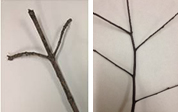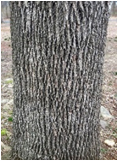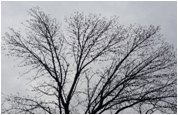Do I have an ash tree?
Look for these signs to identify whether you have an ash tree:

Opposite branching (left) - Branches grow directly across from each other. Most other tree species have alternate branching (right).
 Oar-shaped, winged fruit
Oar-shaped, winged fruit

Compound leaves - Multiple leaflets, usually 5-9, come from the same stem.

“Hershey kiss” shaped buds

Diamond shaped ridges on bark

Straight stout branches
These trees are often mistaken for ash:

Hickory - Branching is alternate and the tree has large hickory nuts instead of samaras.

Tulip poplar - leaves are simple (one leaf per stem) and branching is alternate. Stems are usually tall and straight, with limited lower branching

Walnut - Ridges on bark are much deeper than ash. Leaves have 10-24 leaflets, branching is alternate, and the tree has large walnuts.
- Twigs are green to purple in color. Some leaves will have lobes (resembling a maple leaf), with only about 3 leaflets per leaf.
Photo Acknowledgements:
- Branching, bark and branches: Colleen Kenny, MD DNR Forest Service
- Leaves: J. Seiler, E. Jensen, A. Niemiera, and J. Peterson. Virginia Tech Dept. of Forest Resources and Environmental Conservation.
- Seeds, Buds (white ash), Buds (green ash) : J. Seiler, E. Jensen, A. Niemiera, and J. Peterson. Virginia Tech Dept. of Forest Resources and Environmental Conservation.
- Hickory, Tulip poplar, Walnut and Box elder photo collages: J. Seiler, E. Jensen, A. Niemiera, and J. Peterson. Virginia Tech Dept. of Forest Resources and Environmental Conservation.